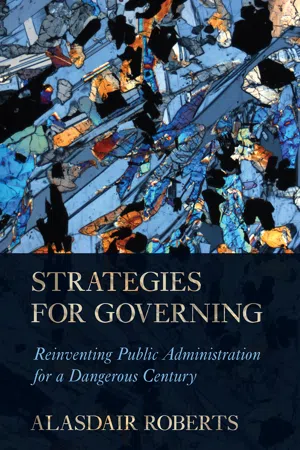
Strategies for Governing
Reinventing Public Administration for a Dangerous Century
- 208 pages
- English
- ePUB (mobile friendly)
- Available on iOS & Android
About this book
With the fields of public administration and public management suffering a crisis of relevance, Alasdair Roberts offers a provocative assessment of their shortfalls. The two fields, he finds, no longer address urgent questions of governance in a turbulent and dangerous world. Strategies for Governing offers a new path forward for research, teaching, and practice. Leaders of states, Roberts writes, are constantly reinventing strategies for governing. Experts in public administration must give advice on the design as well as execution of strategies that effective, robust, and principled. Strategies for Governing challenges us to reinvigorate public administration and public management, preparing the fields for the challenges of the twenty-first century.
Frequently asked questions
- Essential is ideal for learners and professionals who enjoy exploring a wide range of subjects. Access the Essential Library with 800,000+ trusted titles and best-sellers across business, personal growth, and the humanities. Includes unlimited reading time and Standard Read Aloud voice.
- Complete: Perfect for advanced learners and researchers needing full, unrestricted access. Unlock 1.4M+ books across hundreds of subjects, including academic and specialized titles. The Complete Plan also includes advanced features like Premium Read Aloud and Research Assistant.
Please note we cannot support devices running on iOS 13 and Android 7 or earlier. Learn more about using the app.
Information
PART I
Key Ideas
Chapter 1
SUMMARY OF PROPOSITIONS
- Today, and for the foreseeable future, the fundamental unit of political organization is the state.
- Every state is a constituent of an international system of states.
- Every state asserts the exclusive authority to regulate life within a defined territory.
- Every state has leaders; that is, a relatively small group of people who have substantial influence over the ordering of state goals and the means by which those goals are pursued.
- Generally, leaders try to
- maintain and improve their own positions within the state apparatus;
- increase power and legitimacy within the state system;
- increase power and legitimacy within the state’s own territory; and
- increase national prosperity.
- In addition, leaders ought to advance human rights for the population that is subject to their authority.
- Conversely, leaders may construe as threats or problems any developments that jeopardize the pursuit of the above goals.
- The behavior of leaders is guided by governance strategies that describe priorities—that is, the ordering of goals—and the means by which those priorities will be pursued.
- In general, these aspects of the governing environment must be taken into account as leaders set priorities and decide how those priorities will be pursued:
- The distribution of power within the state system.
- The composition, distribution, and movement of the governed population.
- Patterns of economic activity.
- The geography and climate of the governed territory.
- The inventory of social and physical technologies.
- Leaders implement governance strategies by designing, consolidating, administering, and renovating institutions—that is, laws, organizations, programs, and practices. Every state consists of a complex of institutions that expresses a strategy for governing.
- Crafting and implementing governance strategies is difficult for these reasons:
- Goals are not always compatible, so advancing one goal sometimes means compromising another.
- There is uncertainty about which policies are most likely to advance goals.
- The existing body of institutions, laws, and practices must be accommodated.
- The environment for which the strategy is designed is turbulent, so priorities and methods frequently need to be reconsidered.
- The analytic capacity of leaders and executive agencies is strained by the complexity of strategy-making.
- Governance strategies are varied, fragile, and ephemeral. They are designed to accommodate specific conditions, and they must be adjusted frequently as conditions change. This means that institutions, laws, and practices must also be renovated frequently.
- There is an unavoidable conflict between the need to consolidate institutions, laws, and practices, and the need to preserve adaptability.
- The proper timeframe for studying the evolution of governance strategies and the institutions, laws, and practices that express such strategies is at least generational. Shorter timeframes create an illusion of robustness and stability.
- The U.S. experience in crafting and implementing governance strategies is not exceptional.
- Scholars and practitioners in the field of public administration should be experts in the overall design, construction, administration, and renovation of those institutions that constitute a state. They should use this expertise to help leaders craft governing strategies that are effective, durable, and normatively defensible.
Chapter 2
ACKNOWLEDGING THE STATE
In the most generic and ahistorical terms, the state is a set of institutions designed to maintain order in a given territory and protect its population from other states.… The institutions of states typically include decision-making bodies (e.g., councils, senates, parliaments, tribunals), defense and security apparatuses (e.g., armies, navies, militias, national guards), and a set of laws and enforcement mechanisms (e.g., police, councils of elders, judiciary)—all of which are to some extent in the hands of an elite set of rulers and their staff.11
Table of contents
- Acknowledgments
- Introduction
- Part I: Key Ideas
- Part II: Dilemmas in Strategy-Making
- Part III: Applying the Approach
- Conclusion
- A Glossary of States
- Further Reading
- Notes
- Index